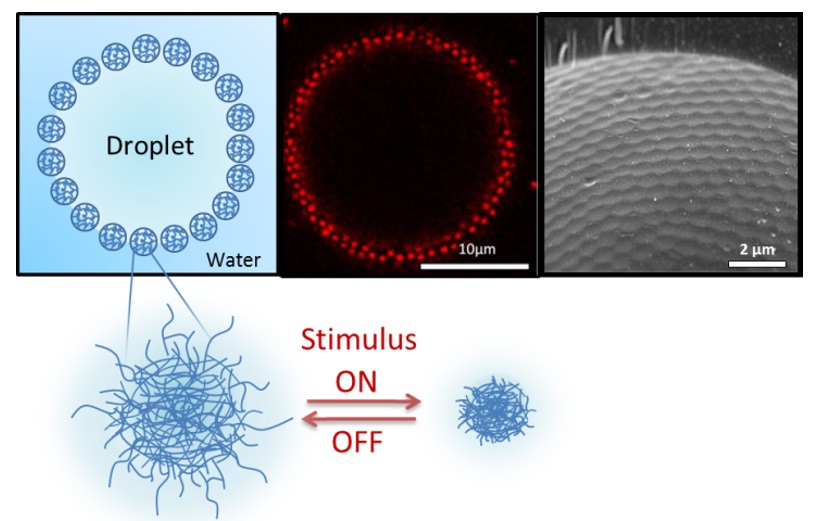Synthesis and assembly of functional particles
- Responsive nanogels for sensing and drug delivery
- Capsules, emulsions and interfaces
- Artificial cells
- Self-assembly of polymers
- Films and materials based on colloidal particles
- Responsive nanogels for sensing and drug delivery
Nanogels and microgels are colloidal particles made of swollen cross-linked polymers. In aqueous solution, these soft particles behave as biomimetic responsive materials, which undergo reversible volume phase transitions in response to changes in their environment. Our group develops different elaboration techniques such as batch synthesis, miniemulsion or microfluidic approach to prepare original architectures based on synthetic or bio-based polymers. Our main objectives are:
1) the development of (bio)sensors, where the swelling degree of nanogels depends on the recognition of the (bio)molecule. Modulation of the swelling degree induces a change in a physical signal (color, luminescence [1], electrochemical signal [2];
2) the release of an active molecule that has been previously encapsulated in the porous structure; they can be used as smart drug delivery systems [3];
3) coupling both sensing and delivery properties lead to closed-loop drug delivery systems. An example is glucose-responsive nanogels, to be used in closed-loop delivery of insulin for type 1 diabetes [4].
On a fundamental point of view, we study the effect of volume phase transition on electrochemical processes.

Representation of a responsive nanogel and examples of nanogel structures :
a) simple nanogel with dangling chains; b) Core-shell nanogel with silica core; c) Hollow nanogel.
Capsules, emulsions and interfaces
Microgels/Nanogels adsorb at liquid interfaces and can be used as stabilizers for emulsions[5]and foams.[6] Because they are responsive, the resulting formulations can be destabilized on demand, upon application of a stimulus. Moreover, nanogels are soft particles, which appear to be deformed at the interface, being either flattened or compressed.[7] We have shown that the deformability is an important criterion to control formulation stability and its rheological properties.[8] In this topic, we are interested in two aspects:
(1) understanding the role of nanogel structure on their interfacial properties and the consequences on emulsion properties;
(2) preparing new materials, in particular capsules, from these assemblies. These capsules may be purely organic or hybrid organic/inorganic (gold, silica), responsive, and have a controlled thickness and porosity.Applications: Responsive emulsions and foams for drug delivery, coatings.

Representation of a drop stabilized by nanogels (a) and confocal microscopy image (b); Close view of the drop surface covered with compressed nanogels (obtained by cryoSEM) (c).
Artificial cells
The building of an "artificial cell" has become a major goal of biophysical chemistry. Within this field, our objective is to develop biomimetic microreactors for the study of biochemical or biological processes devoted to redox reactions, in particular to the synthesis of Reactive Oxygen - Nitrogen Species (ROS, RNS). By confining reactions within a cell-sized compartment (10-100 µm diameter), reactive species (H2O2, NO•, O2•-) can be produced and analyzed in situ with a quantitative and kinetic resolutions. Giant unilamellar vesicles (GUVs) made of phospholipids and fatty acids are used as a biomimetic reactor for the monitoring of glucose oxidase (GOX), NADPH oxidase (NOX) and NO-Synthase activities. Fluorescence microscopy allows individual vesicle observation and the monitoring of reactions triggered by microinjection. Then, released species can be detected by electrochemistry in order to decipher on the enzymatic kinetics and pathways (ex. NO-Synthases). A single ultramicroelectrode is placed at the vicinity of the microreactor membrane and species diffusing through lipidic bilayer, including H2O2 and NO• are measured. Current developments target autonomous microreactors with controlled transport of substrates and products of biological reactions.

Principle of a biomimetic microeactor wherein biochemical and biological reactions can be achieved
and analyzed in order to build up an artificial cell..
Controlling the self-assembly of elementary brick such as polymer chains is a power tool for the conception of smart materials. Our group focuses on the design of complex stimuli sensitive polymeric assemblies like self-healing hydrogels or coacervates, allowing the sequestration and/or the delivery of chemical compounds. Two main approaches are explored by introducing attractive interactions such as:
- Dynamic covalent coupling by using boronate/diol interactions [1]
- Electrostatic coupling with the design of coacervates [2]

Scheme of polymeric self-assembly
Films and materials based on colloidal particles
As a prerequisite for generating more complex architectures with tailored properties, it is a key point to master the assembly of particles on various substrates. Among many techniques, our lab has a very strong expertise in Langmuir-Blodgett and electrophoretic deposition processes. These techniques are powerful tools to generate colloidal assemblies of a very precise thickness over a large range of substrates, whatever their size (from the micro to macroscale) and geometry (planar, cylindrical or more complex ones). In a second step, it is possible to use these colloidal assemblies as molds for obtaining replicas made of metals, conductive or insulating polymers.

Polymeric materials with embedded layers of beads or pores with a controlled size.






